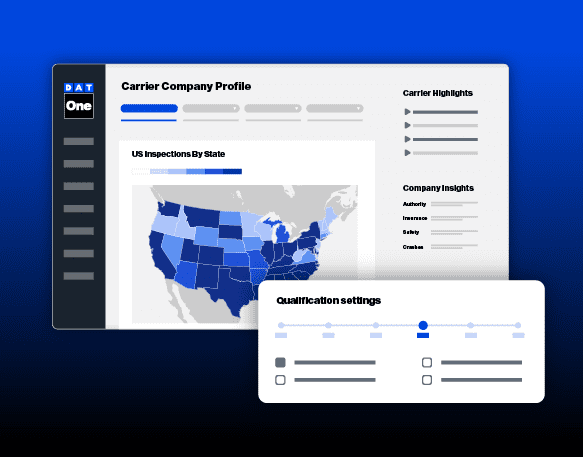The day-to-day operation of your brokerage depends on efficiency, and a transportation management system (TMS) can make a world of difference. A high-quality TMS can streamline your supply chain management and back-office work by combining load board integration, shipment tracking, accounting processes, and document management into one platform, saving you time and money. Designed to help you scale, reduce costs, and improve your productivity, a TMS can pave the way for your business’s success.
Everything brokers need to know about a TMS
Freight brokers juggle a lot—shipment tracking, freight management, supply chain coordination, and keeping customers happy. The right technology can streamline operations, improve efficiency, and boost profitability. That’s where a transportation management system (TMS) comes in.
A TMS is logistics software that centralizes freight workflows, from route optimization to billing automation. It simplifies carrier management, automates manual tasks, and enhances visibility into shipments, helping brokers work smarter, not harder. While some small brokerages manage without a TMS, those handling multiple load boards, high shipment volumes, or complex brokerage operations often find it essential.
But how do you know if a TMS is right for your business? And what should you look for in TMS software?
In this article, we’ll explore the key features, benefits, and considerations to help you decide if a TMS system is the right investment for your brokerage.
TMS vs. load boards: Which is right for you?
Technology plays a crucial role in freight management, but not all tools serve the same purpose. Load boards and TMS systems are two of the most commonly used solutions by freight brokers, and knowing which one to choose can be tricky. While a load board helps you find and book freight, a transportation management system streamlines shipment tracking, carrier management, and brokerage operations.
Each tool offers unique benefits, and depending on your needs, you may find that using both is the best approach. Understanding their key features can help you determine whether you need a TMS, a load board, or a combination of both.
Load boards are essential tools for freight brokers looking to find and book freight quickly. These online marketplaces allow brokers to:
- Post loads and connect with available carriers
- Compare carrier rates to secure the best pricing
- Lock in transportation efficiently
- Access extra features like:
- Shipment tracking for real-time freight visibility
- Credit checks to assess carrier reliability
- Lane rate insights for smarter pricing decisions
- Carrier vetting tools to ensure safe and compliant partners
While load boards focus on freight matching, a transportation management system takes a broader approach to supply chain management and logistics optimization. A TMS helps brokers with:
- Shipment tracking and real-time visibility
- Financial management for invoices, payments, and billing automation
- Document automation to reduce manual paperwork
- Workflow optimization to streamline operations
Load board or TMS – which one do you need?
Load boards and transportation management systems serve different but complementary roles in freight brokerage operations.
- Load boards help brokers find and book freight quickly, connecting them with available carriers.
- A TMS focuses on managing the full logistics process, from shipment tracking to billing automation.
While a load board is all about freight matching, a TMS helps brokers streamline operations and reduce manual work. Many brokers use both tools together—finding loads on a load board, then managing shipments and paperwork within a TMS platform.
If you’re handling more shipments and need a better way to track freight, manage finances, and scale efficiently, a TMS system might be the next step.
Now, how do you know when it’s time to invest in a TMS? Let’s take a look.
How do you know you need a TMS?
There’s a lot of different technology out there, and it can be difficult to know whether a TMS is right for you. One of the main factors involved is how big your business is, and how fast it’s growing.
As your brokerage grows, managing daily operations can become more complex. While spreadsheets, email, and separate software solutions might work for a small operation, they can quickly become inefficient and difficult to manage as you take on more work. A TMS can help streamline these processes. However, using a TMS also involves costs: so how do you know when to take the leap and invest?
Manual processes are slowing you down
One of the biggest signs you might need a TMS is that manual processes have begun to slow you down. If tasks like order entry, billing, and reporting take up too much time, automation through a TMS can help you manage these things a little easier.
Increased data loads and paperwork overwhelm
Another sign you might need a TMS is that you’re starting to deal with increasing amounts of inaccurate or inconsistent data. When you have a lot of carriers and shippers you’re working with, financial records, load tracking, and carrier qualifications can get mixed up.
You might also end up with old documents and have trouble keeping everything up to date. If you keep having to switch between different platforms for dispatching, invoicing, and shipment tracking, you might find that you’re dealing with complications and paperwork overwhelm. Using a TMS can bring these processes and platforms under one roof, so that data inconsistencies can be cleared up.
A good-quality TMS should bring load management, financial tools, and carrier tracking into a single platform, eliminating the issue of inconsistent platforms and data mix-ups.
Encountering frequent customer service challenges
Customer service challenges are another key reason why a TMS might be a good choice for you. If shippers and carriers frequently ask for updates, a TMS can help you to provide these updates in real-time. A TMS gives you access to shipment tracking and other data that can help you communicate more effectively. Finally, if you’re having trouble managing carrier relationships, a TMS can centralize this information and make the process smoother.
If any of these challenges sound familiar, it might be time to consider a TMS. Using a TMS could help your brokerage operate more efficiently and scale more effectively.
Now let’s take a look at some of the key features every piece of good TMS software should have.
Key features of TMS software
A TMS is more than just a tool for shipment tracking. It simplifies day-to-day tasks, including back-office processes, so everything runs more efficiently. The right TMS reduces repetitive work, improves accuracy, and helps you make faster, more informed decisions. Here are some key features that make it a must-have for any business:
- End-to-end visibility. One of the most important features of a TMS is end-to-end visibility. It should provide real-time shipment tracking and full oversight of the transportation process. You can use this information to coordinate with carriers more effectively and provide shippers with timely updates. This improves overall customer service and reduces delays and waiting times at docks for loading or unloading.
- Automated order management. Automated order management is another key function. This eliminates the need for manual load creation, pricing, and documentation. By automating these processes, you can reduce errors and save valuable time.
- Simplified financial management. A TMS also helps simplify financial management with integrated accounting. This brings invoicing, billing, and payment processing together, so you can more easily keep track of invoices and payments. This reduces errors and helps you to handle transactions more quickly and efficiently.
- Analytics and reporting. Analytics and reporting provide additional information about transportation costs, route performance, and carrier reliability. You can use this information to make better decisions and help your shippers and carriers get the most out of their time.
Modern transportation management systems combine these essential tools into a single, easy-to-use platform. When you use a TMS with the right tools, you can work smarter, not harder.
While it might seem like just another piece of broker software, a TMS can allow you to focus on growing your business and doing your job well, rather than managing tedious administrative tasks.
TMS levels: What’s right for your business?
Once you’ve decided you might need a TMS, it’s hard to know which one to choose. Not all types of TMS freight software are the same, and choosing the right one depends on the size and needs of your business.
There are three main levels: basic, mid-tier, and advanced. Let’s look at each of those briefly, and what they’re best for.
Basic TMS
A basic TMS is ideal for small-scale operations, offering essential features like load tracking and reporting. It helps brokers stay organized without unnecessary complexity. If you’re a smaller broker or just starting out, a basic TMS could be the perfect fit.
If you expect or want to grow your business significantly, you could choose a more complex option, although there’s always the possibility to upgrade later. If you don’t need the majority of the tools in an advanced TMS, you could end up paying for things you don’t need.
Mid-Tier TMS
For growing businesses, a mid-tier TMS provides more advanced capabilities, including analytics, billing automation, and system integration. This is useful if you’re dealing with more data or documentation and need more help. These features can help you streamline operations, reduce manual work, and take advantage of the data you’re collecting for more insights into rates, routes, and more.
A mid-tier system is ideal for brokers handling an increasing volume of shipments and looking for ways to improve efficiency.
Advanced TMS
At the highest level, an advanced TMS offers a fully integrated solution with customizable workflows, real-time data, and enterprise-level automation. If your business is shifting from mid-size to enterprise-level, or you’re an enterprise-level business already and you are looking for new tools, an advanced TMS can be helpful. Large-scale brokerages managing high shipment volumes benefit significantly from the ability to fine-tune their processes, optimize carrier relationships, and use data-driven decision-making to stay competitive.
Understanding your business’s current and future needs can help you select the right TMS. Make sure that you invest in a system that suits your needs, and has the option to grow with you.
How a TMS adds value to freight brokers
A TMS isn’t just a tool for shipment tracking and back-office accounting. It can also add significant value to brokerage businesses by increasing efficiency and reducing wasted time.
Increased revenue
One of the biggest benefits of a TMS is increased revenue. By optimizing freight movement, brokers can handle more shipments with fewer resources. With automated processes and improved load management, you can boost profitability without adding overhead. Simply put—time is money, and when you streamline operations, you free up time to focus on growth.
Cost reduction
A TMS helps reduce operational costs through automated invoicing, a lighter administrative workload, and data-driven cost-saving opportunities. Instead of spending time on manual calculations and paperwork, you can allocate resources more effectively. Plus, with automated workflows eliminating repetitive tasks, managing freight becomes easier and allows you more time to focus on maintaining your business.
Customer service
A TMS also enhances customer service by providing real-time shipment updates, so shippers and carriers stay informed, even in case of delays. Plus, with everything organized in one place, you can quickly access important documents and invoices when customers need them. With a well-structured TMS, you can deliver the right information at the right time, keeping your customers satisfied and your operations running smoothly.
Emerging trends in TMS
While TMS software is already widely used throughout the logistics industry, new technologies continue to change the way brokers manage operations. Some recent developments include:
- AI is one of the biggest changes in the industry. Predictive analytics are also increasingly available to help brokers make smarter decisions. By analyzing historical data and market trends, AI-powered TMS platforms can optimize routes, forecast demand, and improve efficiency. AI and machine learning tools will likely continue to grow and become better at what they do: brokers who take advantage of these will reap the benefits for their business.
- Cloud-based solutions are also becoming the standard. These solutions offer scalability and flexibility for businesses of all sizes. Unlike traditional software that requires on-site installation and maintenance, cloud-based TMS platforms allow you to access your data from anywhere. This allows easy collaboration and real-time updates in a much more streamlined way than in the past.
- IoT means “Internet of Things”, and is a type of technology based on sensors and connected devices. For example, GPS trackers and smart sensors can provide real-time shipment data. This includes information on temperatures for frozen goods, vibration and movement levels for fragile transports, and other sensor data. This level of monitoring improves tracking accuracy, enhances visibility into the supply chain, improves the quality of shipping services, and helps brokers proactively address issues.
- Sustainability is also playing a bigger role in logistics. TMS platforms will soon be able to include carbon tracking and optimization features. Goods are increasingly incorporating smart packaging and end-to-end tracking features so that carbon emissions from production to consumption can be calculated. By analyzing fuel consumption and route efficiency, these tools can help brokers play a helpful role in the sustainability process, by reducing their carbon footprint and making greener choices.
- Mobile apps are becoming essential and will be a normal part of TMS systems in the near future. Mobile apps that integrate with TMS systems allow brokers to manage shipments, track loads, and communicate with carriers on the go. With mobile-friendly interfaces, a modern TMS ensures that critical information is always available, no matter where you are.
Quality TMS platforms adapt to industry trends, giving brokers the tools to manage freight more efficiently. As technology advances, freight brokerage will become more streamlined, data-driven, and eco-friendly, with new innovations leading the way.
Want better broker software? Upgrade your TMS.
A TMS improves shipment tracking, streamlines operations, reduces costs, and boosts productivity. With automated workflows, integrated accounting, and real-time insights, it simplifies freight management and supports business growth.
For brokers facing inefficiencies or increasing shipment volumes, the right TMS makes operations easier. It streamlines back-office tasks and documentation, saving time and effort. If your business is growing or administrative work is becoming overwhelming, a TMS can help keep things running smoothly.
Improve your TMS technology with DAT Broker TMS
Managing a freight brokerage comes with challenges, but the right technology can simplify the process. DAT Broker TMS combines accounting, load board integration, real-time tracking, and document management—all in one place. It gives you the tools to streamline operations, reduce costs, and enhance customer service.
With DAT Broker TMS, you can stay organized and scale your business with confidence. Reach out and learn more about it today!




